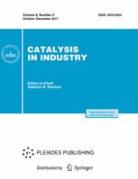CATALYSIS IN CHEMICAL AND PETROCHEMICAL INDUSTRY
Efficient extraction of valuable hydrocarbons from waste gas flows FCC largely depends on the concept, used under selective hydrogenation. The company «Clariant» offers for this purpose two types of catalysts. Sulfided nickel catalyst used on an industrial scale, it is recommended under normal CO levels. For streams containing high concentrations (a few percent) of CO, with small amounts of sulfur or lack developed catalyst precious metal. The off-gases («off»-gases) from catalytic cracking (Fluid Catalytic Cracking – FCC) and deep catalytic cracking units are typically used as fuel, despite the fact that some compounds they contain, such as hydrogen, ethylene, and propylene, have greater value. Until relatively recently, the cost of removal from flue gas using conventional treatment technologies from admixtures of acetylene, methylacetylene and diolefins exceeded commercialized because of the problem of poisoning catalyst impurities present sulfur and heavy metals. This paper discusses the latest developments in technology selective hydrogenation on both new and existing catalysts, which in recent years have allowed to solve these problems and greatly improve the extraction of valuable components.
Embedded materials prepared from MCM-41 together with BE or TON
were synthesized, characterized and tested in the ring opening of decalin in a temperature range of 523–623 K. The characterization results revealed that both microporous and mesoporous phases were present in the catalyst. Ir-modification did not change the phase purity, affecting, however, the acidity due to metalsupport interactions. The parameters studied in ring opening of decalin were support structure, presence of Ir and temperature. The detailed analysis of 2D/3D isomers and ring opening products showed that the main ring opening products contained ethyl side chain. The Ir-modified embedded mesoporous catalysts were active and relatively selective in the ring opening of decalin, giving 35 % selectivity to the ring opening products at 98 % conversion at 573 K and 6 MPa.
The goal is to develop effective catalysts for iso-dewaxing process to reduce the pour point of oils and diesel fuels. Granular catalysts Pt/(ZSM-23–γ-Al2O3) with different contents of platinum and zeolite are synthesized. Physico-chemical properties of the catalysts are studied by XRD, TPD of ammonia, low-temperature nitrogen adsorption-desorption. Influence of catalysts composition and process conditions (1,0–3,0 MPa, 220–400 °С) on the performance iso-dewaxing of 280 °C-KK oil fraction, which is isolated from the products of hydrocracking of vacuum gas oil, was studied in a laboratory setting with a flow reactor. The highest yield, with the same values of fluidity temperature of products was obtained on the catalyst containing 0,30 wt.% platinum on support containing 20 wt.% zeolite ZSM-23 and 80 wt.% γ-Al2O3. Analysis of key performance indicators of iso-dewaxing catalysts based on zeolite ZSM-23 and dewaxing catalysts based on zeolite ZSM-5 showed that the catalysts based on ZSM-23 provide for the reception of dewaxed products with higher yield than laboratory and industrial catalysts based on ZSM-5.
INDUSTRY ENGINEERING PROBLEMS. OPERATION AND PRODUCTION
Various aspects of the traditionally used torches for oxidation of gaseous hydrocarbons, heat exchangers used for heat recovery were considered. There is a description of the method, developed by «FAST ENGINEERING» company for efficient combustion with deep heat recovery of flue gases and maintenance of the desired adiabatic combustion temperature using flameless burners and heat exchangers of a new design. The tests were carried out on the burner experimental stand: dependency drag the granular layer and the content of unburned hydrocarbons, CO and NOх in the flue gas flow rate of the fuel-air mixture and the adiabatic combustion temperature were determined. This method of burning fuel can provide the required temperature of the products combustion to the consumer of thermal energy and reduce the fuel consumption by 5–20 %. Burning of a fuel at the adiabatic combustion temperature is not higher than 1200 °C, virtually eliminating the content of CO and NOх in the flue gas. Designed flameless burner and heat exchangers of a new generation, as well as efficient combustion technology can be used for steam and hot water boilers, gas turbines, catalytic reactors for production of synthesis gas from natural gas for processing into hydrogen, ammonia, methanol, synthetic liquid hydrocarbons and etc.
DOMESTIC CATALYST
The authors conducted a systematic study of carbon material series «Sibunit» (S4) prospective for the processes of oxidative treatment of industrial waste. The effect of the conditions of oxidative treatmentof «Sibunit» (S4) on the chemical composition of its surface and catalytic properties in the deep oxidation of organic toxicants in aqueous solutions was investigated. The influence of the chemical composition of the surface of oxidized under different conditions of the carbon material S4 on its catalytic properties in the liquid-phase aerobic oxidation of phenol, and the catalytic properties of ruthenium catalysts (3 wt.% Ru), prepared on samples of oxidized carbon support S4. Active carbon samples in the oxidation of phenol was detected and it increases with the number of carbonyl and phenolic groups on the carbon surface and decreases with the number of carboxyl and lactone groups. However, the activity of carbon samples noticeably inferior Ru-containing catalysts. The optimal method of pretreatment carbon support to produce the most stable and active Ru/Sibunit catalyst for liquid-phase oxidation of oxygen compounds of the class of phenols is chosen.
The aim is to develop an efficient heterogeneous catalyst for liquidphase epoxidation of olefins by hydrogen peroxide, for this a study of molding processes of titanium zeolite is conducted. Methods are based on granulation and application of the active ingredient to a solid supports. The extrusion granulation of titanium zeolite with binder was preferred. Organic and inorganic compounds, astringent (silica-alumina, aluminum, silicon, and other natural and synthetic materials) have been tested as a binder. Quality of the granular catalysts was evaluated by mechanical strength and catalytic activity – yield of propylene oxide and epichlorohydrin in the epoxidation of corresponding olefins. Optimal combination of mechanical strength (54–68 kg/cm2) and catalytic activity (high yield) was obtained on a titanium zeolite catalyst, prepared prepared c 5,6 oxyaluminum nitrate of 10–15 % (based on Al2O3) as a binder. These XRD and infrared spectroscopy reflect continuing titanium zeolite structure during its formation in the proposed method.
BIOCATALYSIS
Research to increase the activity of iron based catalysts focuses on decreasing the particle size, increasing catalyst dispersion. The chelate compound of iron with humic acid (HA), which macromolecules radii can range from 6 to 50 nm, is truly in a highly dispersed state. Fe2+ or Fe3+ were dispersed finely into the HA matrix through the ion exchange with –COOH groups or chelate with carbonyl group in humic acid macromolecules. X-ray diffraction (XRD) and FT-IR spectrophotometer were used to characterize iron species before or after chelating with humic acid. The results indicate that there exist α-FeOOH, ferrihydrite and amorphous iron in HA-Fe. Most of the work has been conducted on a laboratory scale, and the results show that HA-Fe catalyst was approved for its excellent catalytic activity in coal liquefaction, and the conversion and oil yield of coal have been greatly improved.
There is discussion of the characteristics of directional formation of samples of heterogeneous biocatalysts based on immobilized cells in different micromyces, which are characterized by high cellulases productivity having different substrate specificity (endoglucanase, exoglucanase and beta-glucosidase). Samples of immobilized cells, characterized by maximum productivity on enzymes cellulase complex, selected on the basis of the study of catalytic and operational characteristics designed biocatalysts. Biocatalyst, developed on the basis of spores Aspergillus terreus, immobilized in cryogel of polyvinyl alcohol, is the best. First time we show that the developed biocatalyst steadily maintains a high level of productivity for the full range of cellulases using different substrates, inducers biosynthetic enzymes: birch and oak sawdust, rice and wheat straw. It is possible to effectively use the cellulase complex in saccharification of cellulose of various agricultural residues and conversion of sugars produced in organic solvents (ethanol, butanol), which are promising types of alternative fuel. Concentrations of organic solvents in the media with immobilized cells produce a substantial higher than the concentration of free cells of the same microorganisms.
INFORMATION
CHRONICLE
ISSN 2413-6476 (Online)




























